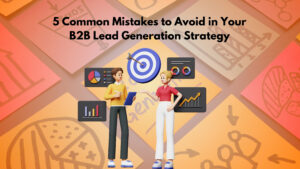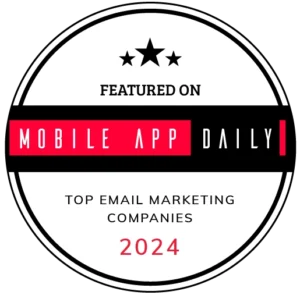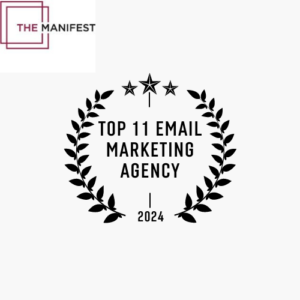A solid B2B lead generation strategy is the backbone of any successful business. It’s the process of attracting, nurturing, and converting potential clients into loyal customers. However, many businesses unknowingly fall into traps that can derail their lead generation efforts. Whether you’re new to B2B marketing or refining an existing strategy, avoiding these five common mistakes will help you drive more qualified leads and improve your sales outcomes.
In this blog, we’ll highlight the top mistakes businesses often make in their B2B lead generation efforts and how you can avoid them for better results.

1. Failing to Define Your Ideal Customer Profile (ICP)
A well-defined Ideal Customer Profile (ICP) is crucial to a successful lead generation strategy. Without it, you’re essentially casting a wide net, hoping to catch anything, but missing the mark on the clients that matter most. Not all leads are created equal. If your marketing efforts aren’t aligned with your ICP, you risk wasting resources on leads that aren’t likely to convert.
How to Fix It: Take time to understand your ideal customers in detail. Your ICP should reflect the companies that benefit most from your product or service. Factors to consider include company size, industry, geographical location, pain points, and buying behaviors. Use analytics from existing customers to build a profile that ensures your marketing efforts reach the right audience.
When your lead generation strategy targets the right companies, your conversion rates will soar, and your sales team will spend more time closing deals with high-value prospects.
2. Overlooking the Power of Content Personalization
If you’re still sending the same generic message to all your prospects, you’re missing out on a major opportunity to increase engagement. In today’s competitive market, personalized content can make a significant difference in capturing the attention of potential clients. A personalized approach makes leads feel understood, valued, and more likely to engage with your content.
How to Fix It: Instead of using a one-size-fits-all strategy, create tailored content that speaks directly to the specific needs and pain points of your target audience. For example, you could offer educational resources such as blogs, whitepapers, or case studies that are specific to each segment of your audience. You can also send targeted emails with offers based on where they are in the buyer’s journey.
The more relevant and personalized your content is, the more likely it is to drive action and create lasting relationships with your leads.
3. Relying Too Heavily on Outbound Tactics
Outbound tactics—like cold calling, direct email campaigns, and paid ads—have long been staples of B2B marketing. While they can still work, relying too much on these methods can be a mistake. Modern buyers are increasingly self-researching, and interrupting them with unsolicited messages may lead to frustration rather than conversions.
How to Fix It: Diversify your approach by incorporating inbound marketing tactics such as SEO, content marketing, and social media engagement. Inbound strategies attract leads who are already looking for solutions, making them more likely to convert. Focus on creating valuable content that answers questions, solves problems, or offers insights. This positions your business as a trusted resource, increasing the chances of converting website visitors into qualified leads.
By combining inbound and outbound strategies, you’ll create a balanced approach that attracts leads both actively searching for solutions and those that may not yet know they need your product or service.
4. Neglecting to Qualify Leads
Not all leads are worth pursuing. Sending every lead directly to your sales team is inefficient and can overwhelm your salespeople. Without a proper qualification process, your team might waste time on leads that are unlikely to close, leading to frustration and missed sales opportunities.
How to Fix It: Implement a lead scoring system that helps you rank leads based on their likelihood of converting. Lead scoring should be based on factors such as engagement, industry fit, budget, and decision-making authority. Once you’ve defined your criteria, use automation tools to filter and prioritize leads. This will ensure that your sales team focuses only on high-quality leads that are more likely to convert, ultimately improving the efficiency of your sales process.
A strong lead qualification system ensures that both your marketing and sales teams are aligned and working towards the same goal—closing more deals.
5. Missing the Follow-Up
Lead generation doesn’t end after the first contact. Many businesses fail to follow up properly, resulting in missed opportunities. It’s important to remember that not every lead is ready to buy immediately. Many prospects require multiple touchpoints before they make a purchase decision.
How to Fix It: Establish a clear follow-up process to nurture your leads through the buyer’s journey. This could include automated email sequences, personal check-ins, or retargeting ads based on their engagement. A well-executed follow-up strategy keeps your business top of mind and ensures that potential customers don’t slip through the cracks.
Track the engagement levels of your leads and adapt your follow-up efforts accordingly. For instance, if a lead shows strong interest by downloading a product brochure, send them a follow-up email with more detailed case studies or a demo request.
A robust follow-up strategy not only increases the chances of conversion but also builds trust and credibility with your leads over time.
Conclusion
Creating a successful B2B lead generation strategy isn’t just about bringing in a large volume of leads; it’s about attracting the right leads and nurturing them into loyal customers. By avoiding these five common mistakes—defining your ICP, personalizing content, balancing outbound and inbound strategies, qualifying leads, and following up effectively—you can significantly improve your results and make every lead count.
Take a moment to assess your current lead generation approach. Could any of these mistakes be holding you back? Often, small adjustments yield substantial gains.
If you’re looking for experts who truly understand the industry and its unique challenges, reach out to SalesHarbor for a quick intro call. We’ll show you how we can seamlessly integrate your desired strategies into your business’s framework, driving more high-quality leads right to your door.



